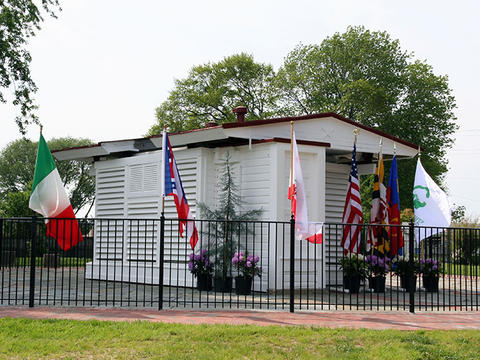
Gaithersburg Latitude Observatory
By Katie Rapp, NIST Research Library
It may come as a surprise that Gaithersburg was a locus for international cooperation in measurement science for more than 60 years before NIST came to the town.
Just a couple of miles from the NIST campus is Observatory Park, Gaithersburg’s only National Historic Landmark and the site of an amazing long-term scientific endeavor. The Gaithersburg Latitude Observatory was one of six identical observatories located around the world along the latitude of 39 degrees 8 minutes north. The other observatories were built in Cincinnati, Ohio; Ukiah, California; Mizusawa, Japan; Charjui, Turkmenistan (which was then part of Russia’s imperial domain); and Carloforte, Italy.
Coordinated by the International Polar Motion Service, the observatories were set up to measure the Earth’s wobble on its polar axis (as measured in relation to movement of the North Pole) through systematic star observations. The Earth’s wobble (called the Chandler wobble or the variation in latitude) was suspected by scientists back in the 1700s, but wasn’t measured until this project.
Observations at the Gaithersburg Observatory began in August 1899 and continued through 1982 (interrupted by World War I). Amazingly, even though the international network of latitude observatories involved two Allied and two Axis nations, the observers continued working together throughout World War II.
Large zenith telescopes were constructed in Berlin and shipped to the latitude observatories. Observers at all six locations carried out a regimented study of specific groups of stars at specific dates, times and durations. As described in a 2011 Gaithersburg Gazette article, “Observers at the stations took measurements of 18 pairs of stars and their angles from different points each night. Observers … waited for the precise moment when two stars would dance through the [telescope] viewfinder.”
The whole exercise took about a minute. But it was a very specific minute. The observer had to be ready and waiting … the stars would not pass twice!
Hours later, the same observations were noted in California, and then at the other observatories around the world. Each recorded the data in a notebook and reported the weekly observations to Japan, where they were compared and analyzed to determine the extent of the polar wobble. “The irregular daily motion of the Earth’s axis was believed to be extremely small, but the extent could be determined by precise measurements of the stars,” according to a brochure published by the city of Gaithersburg (link to pdf).
The observatories measured the wobble to be about 9 meters.
The last observer at Gaithersburg, Mac Currin, told the Gazette, “It was good to watch the stars. I find it incredible that all of these star pairs were picked and lined up to observe, and each night week after week, month after month, year after year, at just the right moment, those stars would pop into view.” Currin conducted observations in Gaithersburg for 25 years. In 1982, human observers were replaced by satellites and the latitude observatories went into retirement.
The data collected at the international latitude observatories continues to be widely used and cited in hundreds of scientific papers. The observatories’ findings have helped geodesists better understand the shape of the Earth and astronomers adjust their observations. The data is used in studies of earthquake mechanisms and climate variation, and to help determine satellite and spacecraft orbit patterns.
This past April, the latitude observatories were again in the news when the NASA Jet Propulsion Laboratory announced a study that solved mysteries about the polar wobble. One type of wobble is caused by changes in Eurasian water storage levels … so a wet year in India causes a slight (1 meter or so) westward swing in the general movement of the wobble. According to the Jet Propulsion Laboratory’s Erik Ivins, co-author of the study, “Historical records of polar motion are both globally comprehensive in their sensitivity and extraordinarily accurate. Our study shows that this legacy data set can be used to leverage vital information about changes in continental water storage and ice sheets over time.”
Although the latitude observatory predates NIST (which arrived in Gaithersburg in the mid-1960s), there is some shared bureaucratic genealogy. The observatory was a project of the U.S. Coast and Geodetic Survey. Earlier called the U.S. Survey of the Coast, this federal agency was first led by Swiss émigré Ferdinand Rudolph Hassler. After the coastal survey, Hassler started the first weights and measures work for the U.S. government, which ultimately came under the domain of the National Bureau of Standards (now called NIST).
The city of Gaithersburg created a nice interpretive park around the observatory building. It’s located just behind Gaithersburg High School on DeSellum Avenue. The city hosts star-viewing events there on a regular basis (using modern telescopes). The original zenith telescope may someday soon come home to the Gaithersburg Community Museum, but for now NOAA is exhibiting it elsewhere.
For a special treat, stop by during Montgomery County Heritage Days (June 25-26) when the observatory building will be opened up. Or you can stop by the park any time for a self-guided tour (the path is shaped like the Chandler wobble!).

